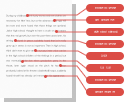《新GRE写作论证论据素材大全》教育类(三)
作者:韦晓亮 来源:极智批改网 2014-03-19
主要论证论据素材包括:、全国性基本课程表、教科书的统治地位、计算机互动课程的应用、计算机学习材料的评估、高度互动软件、如何有效利用计算机、政治对教育的影响、高等职业教育、免费教育、竞争是教育中的一个因素、多学科概述、跨学科整合各学科知识、传统教育、正规学习、社区大学的优点。
29 全国性基本课程表
Learner is at the center of the vision. If we had to look at the two main ideas on which modern
education may be argued, we would boil down to Plato’s liberal education and Rousseau’s
progressive and radical orientations. The vision mentioned above clearly complies with the
progressive orientation where the learner is put at the center. Such revolution, started by Rousseau,
is quite important for us, as it is all about this: putting the learner at the center. People think only
to preserve their child’s life; this is not enough, he must be taught to preserve his own life when he
is a man to bear the buffets of fortune, to brave wealth and poverty, to live at need among the
snows of Iceland or on the scorching rocks of Malta. If we had to look at the old national
minimum curriculum (NMC), the question was “What should we teach?”, and thus putting the
knowledge at the center.
On the other hand, there are other aspects that link the NMC to the other main theorist (mainly
Plato and Dewey). An interesting point to mention would be the idea of justice which links our
curriculum in the year 2000 to what the first curriculum, written by Plato, had mentioned in 400
B.C. In fact, the national curriculum starts with Justice and there is an assumption that we want the
society to be socially just. These ideas show that after observing the various theories of curriculum
that emerged throughout the history of philosophy, we cannot identify one in particular with which
today’s curriculum was designed.
30 教科书的统治地位
The major learning modes in schools and universities are the lecture and textbook. Lectures date at
least back to classical Greece, 2,500 years ago; textbooks come from a more recent technological
development, the printing press. Both textbooks and lectures provide little individualization, so
neither work well considering the wide range of background and experience found with students
today. The advantage of books and lectures is that they can provide integrated whole courses, not
just fragments.
31 计算机互动课程的应用
The new highly interactive courses allow many new possibilities. They could be used in the
conventional institutions of today, or in new forms of institutions derived from ones that already
exist, or they could imply new institutions, particularly based on distance learning.
The highly interactive courses could be used in conventional institutions such as schools and
universities, in whole or in part. Then they simply replace the course already available. But since
these courses stress mastery learning, they should be much more effective than the replaced
courses.
Major advantage of highly interactive courses is that they make new forms of learning institutes
possible, forms that let us attempt solutions to the major problems of education reviewed earlier in
this paper. The idea of new structures for schools and universities is not new, but still a rare
occurrence.
32 计算机学习材料的评估
If the script is on paper, coders are required to translate the design into code, or to transfer the
script to the computer. With the on-line script editor, however, it partially writes the program itself.
Eventually we expect most of coding to be done automatically by the script editor. Visual material
must be created by professionals in such material, following the directions in the script. Note that
teachers are not asked to function as professional designers. Many years ago, in considering the
problems of evaluating learning material, Michael Scriven made the important distinction between
formative evaluation and summative evaluation. Both are important in examining learning
material. Seldom is either done, to the scale that is necessary to assure excellent learning materials.
With both types of evaluation, the computer can play a major role in gathering the data. Student
responses, particularly when not analyzed by the learning program, can be stored and sorted for
later analysis. Human evaluators may also be involved. For material available in several languages,
which aims at a worldwide market, it is important to evaluate it in each of the countries involved.
33 高度互动软件
The notion of highly interactive software has already been mentioned. Although the term
interaction is widely used, most existing software, of all types, can at best be described as only
very slightly interactive. The widespread use of the word interaction predates the existence of
computers. A good model of interaction is a conversation between two people, where each is
paying close attention to what the other person is saying. Such an interactive conversation need
not be concerned with learning, but it may be. Thus Socrates working with a small group of
students, or three or four students working cooperatively, or a student working with an individual
tutor, give us non-computer examples of interactive learning situations. Since there is so little
experience in creating and using highly interactive software, much further experimentation is
needed.
34 如何有效利用计算机
Computers of all varieties can improve education, but not without careful planning from schools
and teachers. First of all, teachers must know how to use the computers, so they can make up
lesson plans and guide their students. Schools must know how to integrate them into the
curriculum. Second, computer labs were available for initial introduction to computers, but the
focus today is on using them in day-to-day study. Children do better when each of them has a
computer. Adults don’t share computers in offices if they want maximum productivity and neither
should children in classrooms. Finally, computers are a tool, not a subject. Most students develop
computer skills if they use them in regular classes, such as math or English. Children love
computers and they are fascinated and motivated by them. That alone is a positive step in the
future of education.
35 政治对教育的影响
The learners in our society should be knowledgeable about what effects politics may have on
education. Such education may be well influenced by politics as power (from whoever may be in
power). Power would be one of the two dimensions to the curriculum and power as domination is
bad and removes justice. In such discussion we may remind that this curriculum was done in three versions with considerable change between the first and the last version. The vision of schools that
we should remove streaming and that education should be inclusive and comprehensive has been“masked” in the last version due to political reasons. To conclude, in this new curriculum it is notthe case of having the objectives listed at the beginning and then simply a description of how each
should be achieved, but it is clearly seen that the vision and philosophy of the curriculum are
consistent throughout. This shows that great planning has been involved in the design of this
document.
36 高等职业教育
Higher vocational education and training takes place at the non-university tertiary level. Such
education combines teaching of both practical skills and theoretical expertise. Higher education
differs from other forms of post-secondary education such as that offered by institutions of
vocational education, which are more colloquially known as trade schools. Higher vocational
education might be contrasted with education in a usually broader scientific field, which might
concentrate on theory and abstract conceptual knowledge. A vocational university is an institution
of higher education and sometime research, which grants professional degrees like professional
bachelor’s degree, professional master’s degree and professional doctorates in a variety of subjects.
There are vocational universities in applied sciences and applied arts.
37 免费教育
Free education (or subsidized education) is education that is provided at no cost to students.
Although primary school and other comprehensive or compulsory education is free in many
countries, the Nordic countries are all examples of countries where education is free all the way up
including post-graduate studies. In Sweden and Finland, there is not even a fee for foreign
students enrolling at a university (exchange or not), although they may not be eligible for the
monthly study allowance and loan most nationals are.
Nowadays, as for many parts of the world outside Scandinavia, free education usually comes to
students in the form of scholarship and grants, if they cover all or most of students’ expenses while
at school. Patrons for grants and scholarships may be individuals, institutions (often the school
itself), advocacy initiatives, etc. They may have economic (e.g. tax-deductibility), humanitarian,
charitable or religious reasons. Ireland has free education at all levels, including college and
university which are also free.
38 竞争是教育中的一个因素
Competition is a factor in education. On a global scale, national education systems, intending to
bring out the best in the next generation, encourage competitiveness among students by
scholarships. Upon receipt of their academic results, students tend to compare their grades to see
who is better. For severe cases, the pressure to perform in some countries is so high that it results
in stigmatization of intellectually deficient students or even suicide as consequence of failing the
exams, Japan being a prime example. This has resulted in critical revaluation of examinations as a
whole by educationists. Critics of competition as opposed to excellence as a motivating factor in
education systems, such as Alfie Kohn, assert that competition actually has a net negativeinfluence on the achievement levels of students and that it “turns all of us into losers”.Competitions also make up a large proponent of extracurricular activities that students partake in.
39 多学科概述
“Interdisciplinarity” in referring to an approach to organizing intellectual inquiry is an evolvingfield, and stable, consensus definitions are not yet established for some subordinate or closely
related fields.
An interdisciplinary community or project is made up of people from multiple disciplines and
professions who are engaged in creating and applying new knowledge as they work together as
equal stakeholders in addressing a common challenge. The key question is what new knowledge(of an academic discipline nature), which is outside the existing disciplines, is required to
address the challenge. Aspects of the challenge cannot be addressed easily with existing
distributed knowledge, and new knowledge becomes a primary subgoal of addressing the common
challenge. The nature of the challenge, either its scale or complexity, requires that many people
have interactional expertise to improve their efficiency working across multiple disciplines as well
as within the new interdisciplinary area. An interdisciplinarary person is a person with degrees
from one or more academic disciplines with additional interactional expertise in one or more
additional academic disciplines, and new knowledge that is claimed by more than one discipline.
Over time, interdisciplinary work can lead to an increase or a decrease in the number of academic
disciplines.
40 跨学科整合各学科知识
Transdisciplinarity acts as a principle for a unity of knowledge beyond disciplines.
Transdisciplinarity (a term introduced in 1970 by Jean Piaget) concerns that which is at once
between the disciplines, across the different disciplines, and beyond each individual discipline. Its
goal is the understanding of the present world, of which one of the imperatives is the overarching
unity of knowledge. The transdisciplinarity is defined by Basarab Nicolescu through three
methodological postulates: the existence of levels of reality, the logic of the included middle, and
complexity. In the presence of several levels of Reality the space between disciplines and beyond
disciplines is full of information. Disciplinary research concerns, at most, one and the same level
of Reality; moreover, in most cases, it only concerns fragments of one level of Reality. On the
contrary, transdisciplinarity concerns the dynamics engendered by the action of several levels of
Reality at once. The discovery of these dynamics necessarily passes through disciplinary
knowledge. While not a new discipline or a new superdiscipline, transdisciplinarity is nourished
by disciplinary research; in turn, disciplinary research is clarified by transdisciplinary knowledge
in a new, fertile way. In this sense, disciplinary and transdisciplinary research are not antagonistic
but complementary.
41 传统教育
Traditional education is a long-established and generally accepted custom that is found in schools
that society deems appropriate. Advocates of education reform want to promote the adoption of
progressive education practices. In the eyes of reformers, traditional methods must be transformed
to a high-performance system. However, many parents and conservative citizens prefer retaining
time-tested methodology. In order to define reformed methods, it is first necessary to define what
is traditional.
Traditional education denotes a time tested set of strategies meant to develop students’ minds so that they can better participate in American society as informed, independent thinkers. Traditional
education is largely misunderstood and derided as extremist. In fact, most of what would be
termed “traditional education” actually produces superior results and more independent thinkers
as compared to progressive, student-centered approaches.
42 正规学习
To fully understand informal learning, it’s useful to define the terms “formal” and “informal”.
Formal learning happens when knowledge is captured and shared by people other than the original
expert or owner of that knowledge. The knowledge can be captured in any format—written, video,
audio—as long as it can be accessed anytime and anywhere, independent from the person who
originally had it. Examples of such formal knowledge transfer include live virtual-classroom
courses with prepared slides, self-paced off-the-shelf instructional CBT courses, books, video—and audiotapes, team rooms in which documents are stored, digital libraries and repositories, a
real-time seminar on the Web (or webinar), electronic performance-support tools, programs
accessed during a job or task, instructor-led courses that follow an outline, repeatable lecture labs,
a recorded Web-based meeting, or even e-mails that can be forwarded. Formal learning often
requires prerequisites, pre-assessments and post-assessments, tests, and grades, and it sometimes
results in certification. It is often presented by an instructor, and attendance and outcomes are
tracked.
43 社区大学的优点
Community colleges are geared toward local students and local needs. Students who could not
afford campus or off-site housing at a four-year college, or for other reasons, can attend courses
while staying in their local community (though some colleges do offer student housing). Also,
community colleges can work with local businesses to develop customized training geared toward
local needs, whereas a four-year institution generally focuses on state-wide or national needs.
Some community colleges have “concurrent enrollment” programs, allowing local high school
students to “jump start” their college career by taking classes at the community college that
count both toward their high school diploma and as college credit (mainly in core areas such as
history and political science). Policies and classes offered vary with different agreements existing
between the community college and high schools.
The “open enrollment” policy benefits students with mediocre high school academic records,
students who dropped out of high school or were expelled, students who recognized the benefits of
college education relatively late in life, and students whose personal obligations or limited
financial resources prevented them from attending college on the traditional schedule.
批改及润色体验馆 想知道您的作文、口语、文书将如何被我们的专家批改及润色吗? 查看更多
 马上体验口语批改
马上体验口语批改
 马上体验作文批改
马上体验作文批改
 马上体验文书润色
马上体验文书润色
作文题库:
托福-综合写作 托福-独立写作 雅思-小作文 雅思-大作文 GRE-Issue GRE-Argument GMAT-Argument SAT-Essay ACT-McGraw-Hill ACT-历年代表性作文题目考研-小作文 考研-大作文 四级-作文 六级-作文 专四-大作文 专四-小作文 专八-作文 高考-新课标一 高考-新课标二 高考-北京 高考-天津 高考-广东 高考-四川 高考-辽宁 高考-安徽 高考-福建 高考-湖南 高考-湖北 高考-陕西 高考-浙江 高考-山东 高考-上海 高考-重庆 高考-江苏 高考-江西 高考-杭州外国语学校 高考-郑州四中 高考-章丘
口语题库:
托福-Question 1 托福-Question 2 托福-Question 3 托福-Question 4 托福-Question 5 托福-Question 6 雅思-Part 1 雅思-Part 2 雅思-Part 3求职面试-500强企业高频通用英文面试题目100道 求职面试-各大企业常用场景英文面试题目
签证面签-你是谁 签证面签-你去做什么 签证面签-你有能力去做吗 签证面签-你会回来吗
留学面试-关于学校及专业 高考-高考口语
文书润色:
留学文书 学术论文 商务文书 求职文书 课程作业 书稿润色 学术论文试用 学术论文摘要文章推荐
- 《新GRE写作论证论据素材大全》艺术类(二)
- 《新GRE写作论证论据素材大全》艺术类(三)
- 《新GRE写作论证论据素材大全》艺术类(一)
- 《新GRE写作论证论据素材大全》文化类(三)
- 《新GRE写作论证论据素材大全》文化类(二)
- 《新GRE写作论证论据素材大全》文化类(一)
- 《新GRE写作论证论据素材大全》政治类(二)
- 《新GRE写作论证论据素材大全》政治类(一)
- 《新GRE写作论证论据素材大全》学习类(四)
- 《新GRE写作论证论据素材大全》学习类(三)
- 《新GRE写作论证论据素材大全》学习类(二)
- 《新GRE写作论证论据素材大全》学习类(一)
- GRE Argument 168 范文+逐段点评+全篇总评
- 《新GRE写作论证论据素材大全》科技类(三)
- GRE Argument 152 范文+逐段点评+全篇总评
- GRE Argument 160 范文+逐段点评+全篇总评
- 《新GRE写作论证论据素材大全》科技类(二)
- GRE Argument 135 范文+逐段点评+全篇总评
- GRE Issue 104 (107) 范文+逐段点评+全篇总评
- 《新GRE写作论证论据素材大全》科技类(一)
- GRE Argument 132 范文+逐段点评+全篇总评
- 《新GRE写作论证论据素材大全》教育类(三)
- GRE Issue 123 范文+逐段点评+全篇总评
- GRE Argument 142 范文+逐段点评+全篇总评
- 《新GRE写作论证论据素材大全》教育类(二)
- GRE Issue 143 范文+逐段点评+全篇总评
- GRE Argument 170 范文+逐段点评+全篇总评
- 新GRE写作论证论据素材大全》教育类(一)
- GRE Issue 114 范文+逐段点评+全篇总评
- 【GRE Argument 113 范文+逐段点评+全篇总评】
- 《新GRE写作论证论据素材大全》行为类(三)
- GRE Issue 101 范文+逐段点评+全篇总评
- GRE Argument 109-110 范文+逐段点评+全篇总评
- 《新GRE写作论证论据素材大全》行为类(二)
- GRE Issue 89 范文+逐段点评+全篇总评
- GRE Argument 101 范文+逐段点评+全篇总评
- 《新GRE写作论证论据素材大全》行为类(一)
- 《新GRE写作论证论据素材大全》社会发展类三
- 《新GRE写作论证论据素材大全》社会发展类二
- GRE Argument10范文+逐段点评+全篇总评
- GRE Issue8范文+逐段点评+全篇总评
- GRE Issue13范文+逐段点评+全篇总评
- GRE Argument8范文+逐段点评+全篇总评
- GRE Issue7范文+逐段点评+全篇总评
- GRE Issue4范文+逐段点评+全篇总评

使用有问题?请联系我们的在线专家
工作时间:09:00AM - 08:00PM
 专家在线
专家在线





